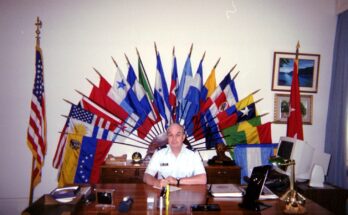The first American soldier killed in WWII was killed on 21 April, 1940, during the German bombing of Norway.
The highest ranking U.S. soldier ever killed by friendly fire was Lt. Gen. Leslie J. McNair. He was killed in France in July, 1944, in an ill-conceived attempt to use heavy bombers to support front line troops. In bad weather, the bombs fell 500 yards short and killed McNair and more than 100 others. War correspondent Ernie Pyle survived the attack and went on to the Pacific where he was killed by a Japanese sniper on 18 April, 1945.
The oldest American soldier in WWII was 56 years old. He was Brigadier General Theodore Roosevelt, Jr, who led his troops in the first wave to hit Utah Beach. Roosevelt came ashore with a pistol and a walking cane. He was the only General Officer to come ashore on D-Day. On that same day his son, Army Captain Quentin Roosevelt II, came ashore a few miles away on Omaha Beach. General Roosevelt died a few weeks later in France of a heart attack.
Regardless of novels and movies portraying America almost single-handedly winning WWII, the biggest, most ferocious battles were fought in the East. The largest battle in human history, Stalingrad, from August 1942 thru February 1943 produced 2.2 million casualties. 100,000 German soldiers starved or froze to death. 90,000 prisoners were taken by the victorious Russians of whom 6,000 survived.
A few months later in July and August of 1943 occurred the largest tank battle in history. The battle of Kursk saw a combined German and Russian force of 6,000 tanks, 4,000 aircraft and 2,000,000 troops. The total killed, captured, and injured was over 600,000. Although the Russians lost far more troops and equipment than did the Germans, they were victorious. The Russians were able to replace their losses from their vast arsenal of men and machines. The Germans were not and from that point on were in constant retreat never to launch any substantial offensive actions. The Russian commander, Gen Zhukov, was rewarded by being given command of all Russian forces advancing to Berlin.
At the time he was given overall command of the D-Day invasion, General Dwight Eisenhower had never commanded a combat unit. He was selected for his great talent in organizing operations and especially his success in bringing bitter rivals together to work effectively. Case in point, Patton and Montgomery who intensely disliked each other.
Eisenhower is given due credit for a monumental decision he made to halt the allied forces driving further East into Germany. Eisenhower knew that allied forces could continue and take Berlin. He halted his forces for two reasons which he stated plainly. First, to push on would result in thousands of unnecessary allied casualties. Second, he said “let the Russians lose the troops instead and then take their revenge against the Germans”. The Russians did both those things.



